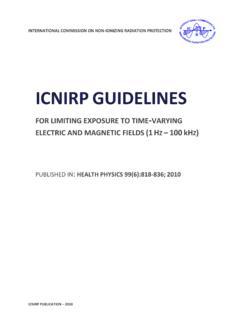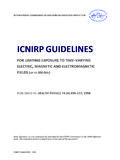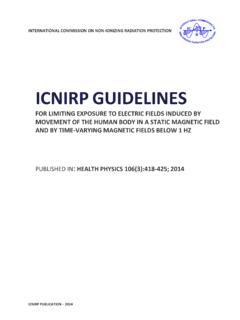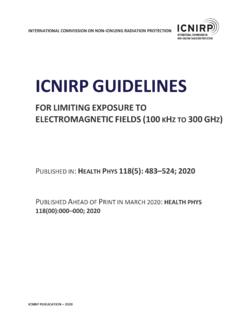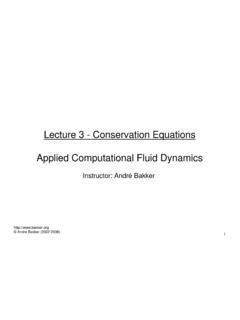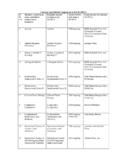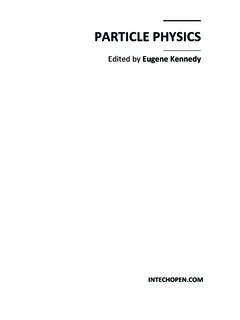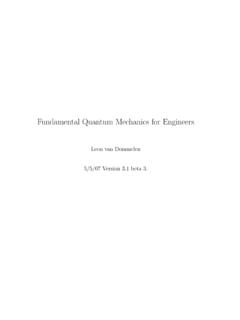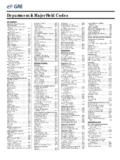Transcription of ICNIRP GUIDELINES
1 INTERNATIONAL COMMISSION ON NON IONIZING RADIATION PROTECTION ICNIRP PUBLICATION 2009 ICNIRP GUIDELINES ON LIMITS OF EXPOSURE TO STATIC MAGNETIC FIELDS PUBLISHED IN: HEALTH physics 96(4):504 514; 2009 ICNIRP GuidelinesGUIDELINES ON LIMITS OF EXPOSURE TO STATICMAGNETIC FIELDSI nternational Commission on Non-Ionizing Radiation Protection*INTRODUCTIONTHE RAPID development of technologies in industry andmedicine using static magnetic fields has resulted in anincrease in human exposure to these fields and has led toa number of scientific studies of their possible healtheffects. The World Health Organization (WHO) recentlydeveloped a health criteria document on static electricand magnetic fields within the Environmental HealthCriteria Program (WHO 2006). The document contains areview of biological effects reported from exposure tostatic fields and, together with other recent publications[mainly International Commission on Non-Ionizing Ra-diation Protection ( ICNIRP ) 2003, McKinlay et al.]
2 2004,and Noble et al. 2005], serves as the scientific databasefor the development of the rationale for the guidelinesdescribed in the current document, which supersedethose published by ICNIRP in 1994 ( ICNIRP 1994).SCOPE AND PURPOSET hese GUIDELINES apply to occupational and generalpublic exposure to static magnetic fields. The guidelinesdo not apply to the exposure of patients undergoingmedical diagnosis or treatment. Detailed consideration ofprotection of patients is given in an ICNIRP statement onprotection of patients undergoing a magnetic resonanceimaging (MRI) examination ( ICNIRP 2004; ICNIRP inpreparation).QUANTITIES AND UNITSW hereas electric fields are associated with the pres-ence of electric charge, magnetic fields result from thephysical movement of electric charge (electric current).Similarly, magnetic fields can exert physical forces onelectric charges, but only when such charges are inmotion.
3 A magnetic field can be represented as a vectorand may be specified in one of two ways: as magneticflux densityBor as magnetic field expressed in teslas (T) and amperes per meter (Am 1), respectively. In a vacuum and with good approxi-mation in air,BandHare related by the expressionB oH.(1)The constant of proportionality oin eqn (1) is termedthe permeability of free space and has the numericalvalue 4 10 7expressed in henrys per meter (Hm 1). Thus, to describe a magnetic field in air ornonmagnetic materials (including biological materials)with an adequate approximation, only one of theBorHquantities needs to be magnitude of the forceFacting on an electriccharge q moving with a velocityvin a direction perpen-dicular to a magnetic flux densityBis given by theexpressionF q(v B).(2)The direction of the force (the Lorentz force) is deter-mined from the vector product of the velocity of thecharge and the magnetic flux density and is thereforealways perpendicular to the direction of the flow ofelectric charge.
4 As a result, the interaction of a magneticfield with electric charge will result in a change ofdirection of the flow of the charge, but never a change invelocity. Static magnetic fields do not deposit energy magnetic flux density, measured in teslas, isaccepted as the most relevant quantity for relating tomagnetic field effects. The magnetic flux within a givenarea of surface is the product of the area and thecomponent of the magnetic flux density normal to summary of magnetic field quantities and units isprovided in Table international (SI) units are the interna-tionally accepted units for expressing quantities in the* ICNIRP ,c/oBfS G. Ziegelberger, Ingolstaedter Landstr. 1,85764 Oberschleissheim, correspondence contact G. Ziegelberger at the above address,or email at accepted4 December2008)0017-9078/09/0 Copyright 2009 Health physics Society504scientific literature.
5 For a more complete list anddiscussion of concepts, quantities, units, and terminol-ogy for non-ionizing radiation protection, the reader isreferred to the relevant ICNIRP publication (ICNIRP2003).SOURCES OF EXPOSUREThe natural static magnetic field of the Earth is 50 T and, depending on the geographic location, variesfrom 30 to 70 T. Magnetic flux densities of the orderof 20 T are produced under high direct current trans-mission lines. In the future there is a potential forexposure to greater magnetic flux densities due to thedevelopment of new transport technologies. Fast passen-ger trains based on magnetic levitation produce relativelyhigh magnetic flux densities close to the motor. How-ever, for both magnetically-levitated trains and conven-tional electric trains, the fields inside thepassenger cabinare relatively low, below 100 T, but localized magneticfields of up to several mT at floor level can result from thepresence of inductors beneath the floor of passengercoaches (WHO 2006; ICNIRP 2008).
6 Other sources ofstatic magnetic fields in residential and occupational envi-ronments include small permanent magnets in magnet clipsand magnetic attachments (such as bags, buttons, magneticnecklaces and bracelets, magnetic belts, magnetic toys, etc),which generate local static fields in excess of highest non-occupational exposure occurs inpatients undergoing a diagnostic examination by mag-netic resonance (MR), a technique that is used to obtaindiagnostic information about the body and increasinglyto guide surgical interventions within the body. MR isbased on the phenomenon of nuclear magnetic resonanceand underlies MRI and magnetic resonance spectroscopy(MRS). In MR procedures, magnetic flux densities typ-ically range from to 3 T and the exposure is usuallylimited to less than 1 h, but can be a few hours in duration(Gowland 2005).Interventional medical procedures underdirect real-time control by MRI are becoming increasinglycommon.
7 These procedures also lead to increased occupa-tional exposure, especially for medical professionals (sur-geons, radiologists, nurses, and technicians). During suchprocedures the medical staff may be within the mainmagnetic field region for a long period of time, up to a fewhours. Increased staff exposure can also occur in emergencysituations, when the medical professionals have to intervenevery close to the patient. In addition, brief staff exposuresoccur during movement of patients in and out of MRsystems. Finally, staff involved with the manufacture ormaintenance of these MR systems are also occupationallyexposed to high static magnetic MRI is now widely used in academic andmedical research on human brain function. MR systemsusing higher magnetic fields, up to about 10 T, arecurrently used for research in several institutions world-wide, and operate with special approval from a localinstitutional review board or equivalent entity.
8 Exposurescan also occur during other medical applications of staticmagnetic fields, such as the use of magnets to holdvarious prostheses in place or for magnetic navigation,where moveable permanent magnets are used to guidethe tip of cardiac catheters; however, these devicesproduce only localized fields are also produced in high-energytechnologies such as thermonuclear reactors, magneto-hydrodynamic systems and superconducting facilities that use bubble chambers, particleaccelerators, superconducting spectrometers, and isotopeseparation units also have areas with high magnetic fluxdensity around these devices. Other industries whereexposure to strong magnetic fields occur are thoseinvolving electrolytic processes such as chlorine oraluminum production, where typical exposures for mostof the working day are a few mT, with peak exposures upto several tens of mT, and in the manufacture ofpermanent magnets and magnetic OF THE SCIENTIFIC EVIDENCEI nteraction mechanismsThe three established physical mechanisms throughwhich static magnetic fields interact with living matterare magnetic induction, magneto-mechanical, and elec-tronic mechanism originatesthrough the following types of interaction: Electrodynamic interactions with moving electrolytes:Static fields exert Lorentz forces on moving ioniccharge carriers and thereby give rise to induced elec-tric fields and currents.
9 This interaction is the basis ofmagnetically-induced potentials associated with flow-ing blood which have been theoretically analyzed(Kinouchi et al. 1996). These authors suggested thatthe sinoatrial node of the heart that controls cardiacTable magnetic field quantities and correspondingSI (A)Current densityJAmperes per square meter (A m 2)Magnetic field strengthHAmperes per meter (A m 1)Magnetic flux Weber (Wb or T m2)Magnetic flux densityBTesla (T)Permeability Henrys per meter (H m 1)Permeability of free space o4 10 7Hm 1505 ICNIRP GUIDELINES on limits of exposure to static magnetic fields ICNIRP pacing may be the region most sensitive to current andcalculate that, for a field of 5 T, the current density inthis region is around 100 mA m 2, which is around10% of the maximum endogenous current from car-diac electrical activity, rising to around 20% for 10 detailed assessment of the effects of the electricfields on cardiac function using computational modelsof cardiac electrophysiology indicated that, whilefields up to 8 T are unlikely to affect the heart rate andrhythm, this would not necessarily be true for higherfields (Holden 2005).
10 Induced electric fields and currents:Time-varyingmagnetic fields induce electric currents in living tis-sues in accordance with Faraday s law of may also be induced by movement in a staticmagnetic field. In particular, motion along a fieldgradient or rotational motion, either in a uniform fieldor in a field gradient, produces a change in flux linkagewhich induces an electric current, in contrast to linearmotion of the body within a uniform static field. Withregard to linear movement in a gradient field, themagnitude of the induced currents and associatedelectric fields increases with velocity of the movementand amplitude of the gradient. Calculations suggestthat such induced electric fields will be substantialduring normal movement around or within fields 2 3 T (Crozier and Liu 2005), and may account forthe numerous reports of vertigo and nausea and mag-netic phosphenes experienced by patients, volunteers,and workers moving in such fields (Schenck et ; Chakeres and de Vocht 2005; de Vocht et ).
